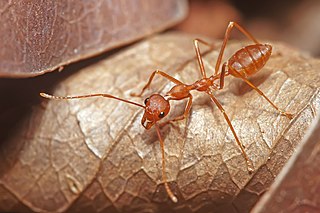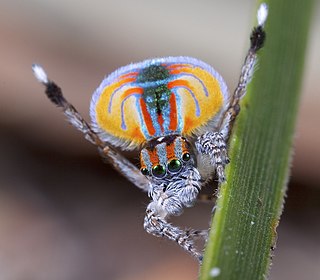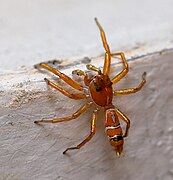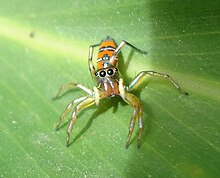
Jumping spiders are a group of spiders that constitute the family Salticidae. As of 2019, this family contained over 600 described genera and over 6,000 described species, making it the largest family of spiders at 13% of all species. Jumping spiders have some of the best vision among arthropods and use it in courtship, hunting, and navigation. Although they normally move unobtrusively and fairly slowly, most species are capable of very agile jumps, notably when hunting, but sometimes in response to sudden threats or crossing long gaps. Both their book lungs and tracheal system are well-developed, and they use both systems. Jumping spiders are generally recognized by their eye pattern. All jumping spiders have four pairs of eyes, with the anterior median pair being particularly large.

Oecophylla smaragdina is a species of arboreal ant found in tropical Asia and Australia. These ants form colonies with multiple nests in trees, each nest being made of leaves stitched together using the silk produced by the ant larvae: hence the name 'oecophylla' [Greek for 'leaf-house'].

Cosmophasis is a genus of spiders in the family Salticidae. They are predominantly Southeast Asian, while some species occur in Africa and Australia. Although most species more or less mimic ants, there are also colorful species that follow a different strategy.

Maratus is a spider genus of the family Salticidae. These spiders are commonly referred to as peacock spiders due to the males' colorful and usually iridescent patterns on the upper surface of the abdomen often enhanced with lateral flaps or bristles, which they display during courtship. Females lack these bright colors, being cryptic in appearance. In at least one species, Maratus vespertilio, the expansion of the flaps also occurs during ritualised contests between males. The male display and courtship dance are complex, involving visual and vibratory signals.

Castianeira is a genus of ant-like corinnid sac spiders first described by Eugen von Keyserling in 1879. They are found in Eurasia, Africa, and the Americas, but are absent from Australia. Twenty-six species are native to North America, and at least twice as many are native to Mexico and Central America.

Prostheclina pallida is a species of spider in the family Salticidae, native to Eastern Australia. It was described by Keyserling in 1882, and remained the only species in the genus until 2007, when six more species were described.

Cosmophasis umbratica is a species of jumping spider found in South and Southeast Asia. They are members of the family Salticidae and the genus Cosmophasis. They are commonly spotted on green vegetation. C. umbratica shows extreme dimorphism when viewed under UV light: males reflect UV on all body parts that are displayed during intraspecific interaction, while females and juveniles do not reflect UV at all. It seems that C. umbratica uses this in sexual signaling. A similar phenomenon is found in some butterflies. For example, several species of Colias and Gonepteryx, both of the family Pieridae, also display sexual signaling.

Australia has a number of highly venomous spiders, including the Sydney funnel-web spider, its relatives in the family Hexathelidae, and the redback spider, whose bites can be extremely painful and have historically been linked with deaths in medical records. Most Australian spiders do not have venom that is considered to be dangerously toxic. No deaths caused by spider bites in Australia have been substantiated by a coronial inquest since 1979. There are sensationalised news reports regarding Australian spiders that fail to cite evidence. A Field Guide to Spiders of Australia published by CSIRO Publishing in 2017 featuring around 836 species illustrated with photographs of live animals, around 381 genera and 78 families, introduced significant updates to taxonomy from Ramirez, Wheeler and Dmitrov.

Mexcala angolensis is a species of jumping spider in the genus Mexcala that is endemic to Angola, after which it is named. The spider was first defined in 2009 by Wanda Wesołowska, one of over 500 that the arachnologist described during her career. The spider is medium-sized, with a brownish carapace typically 3.4 mm (0.13 in) long and a light brown abdomen typically 3.0 mm (0.12 in) long that has an indistinct dark streak that runs down the middle. It mimics ants and ant-like wasps, living alongside and preying upon them. The male can be distinguished from other Mexcala species by the small teeth at the end of its tibial apophysis, or spike, and the lack of a bump on its palpal bulb. The female has not been described.

Mexcala ovambo is a species of jumping spider in the genus Mexcala that is endemic to Namibia. The spider was first defined in 2009 by Wanda Wesołowska, one of over 500 that the arachnologist described during her career. The spider is medium-sized and slender, with a yellowish-brown body carapace typically 3.1 mm (0.12 in) long and an abdomen typically 4.7 mm (0.19 in) long. It mimics ants, living alongside and preying upon them. The female can be distinguished from the related Mexcala quadrimaculata in its widely spaced depressions in the epigyne. The male has not been described.

Mexcala synagelese is a species of jumping spider in the genus Mexcala that lives in Angola, Democratic Republic of the Congo, Ivory Coast, Nigeria and Sudan. The spider was first defined in 2009 by Wanda Wesołowska, one of over 500 that the arachnologist described during her career. It mimics ants and ant-like wasps, living alongside and preying upon them. The spider is medium-sized, with a dark brown carapace between 2.7 and 3.2 mm long and a pale brown to dark brown abdomen between 3.2 and 4.0 mm long. The male has three strips on its abdomen while the female has a more complex pattern of dark bands and light patches. The spider has long thin brown legs. It has good eyesight, which it uses when hunting and also during courtship. The male palpal bulb has a long tibial apophysis, or spike, that curves in towards the bulb. The female epigyne has two shallow depressions and short seminal ducts that lead to long receptacles.

Mexcala formosa is a species of jumping spider in the genus Mexcala that is endemic to Ethiopia. The spider was first defined in 2008 by Wanda Wesołowska and. It mimics ants, living alongside and preying upon them. Only the male has been described. It is a medium-sized spider, with a cephalothorax typically 2.9 mm (0.11 in) long and an abdomen typically 3.5 mm (0.14 in) long. The carapace is dark brown and the eye field black. The spider is similar to the related Mexcala agilis and Mexcala elegans, but can be distinguished by its thinner tibial apophysis and the white scales on its cymbium.

Mexcala torquata is a species of jumping spider in the genus Mexcala that lives in Guinea and Ivory Coast. It was first defined in 2009 by Wanda Wesołowska, one of over 500 that the arachnologist described during her career. The spider is medium-sized, with a dark brown carapace that is between 3.0 and 3.3 mm long and a brown abdomen between 3.0 and 3.7 mm long. It has long thin legs and serrated chelicerae. Similar to other species in the genus, it mimics ants and ant-like wasps, living alongside and preying upon them. The female has a distinctive fillet on the back of its abdomen, after which the species is named. However, it can be most easily distinguished from other spiders in the genus by its relatively small copulatory organs, specifically its very small epigyne, seminal ducts and embolus.

Mexcala vicina is a species of jumping spider in the genus Mexcala that is endemic to South Africa, found in Mpumalanga. The spider was first defined in 2009 by Wanda Wesołowska, one of over 500 that the arachnologist described during her career. It mimics ants and ant-like wasps, living alongside and preying upon them. The spider is medium-sized, with a dark brown carapace typically 2.5 mm (0.098 in) long and a brown abdomen between 2.3 and 2.7 mm long. The abdomen has a pattern made up of three dark streaks in a triangular shape. The male has a straight embolus. The female has not been identified.

Mexcala smaragdina is a species of jumping spider in the genus Mexcala that is endemic to Nigeria. The spider was first defined in 2012 by Wanda Wesołowska and G. B. Edwards. Spiders of the genus mimic ants and ant-like wasps, living alongside and preying upon them. The spider is medium-sized, with a cephalothorax typically 2.5 mm (0.098 in) long and an abdomen 2.7 mm (0.11 in) long. The male has a hooked embolus that is shorter than the related Mexcala caerulea but otherwise the male copulatory organs are similar. The female has not been identified. The spider is most easily distinguished by the green-metallic sheen on its body, which is referred to in the species name.

Mexcala macilenta is a species of jumping spider in the genus Mexcala that lives in Ethiopia and Tanzania. The spider was first defined in 2000 by Wanda Wesołowska and Anthony Russell-Smith. It mimics ants and ant-like wasps, living alongside and preying upon them. The spider is medium-sized to large, with a brown carapace between 3.2 and 3.4 mm long and a rusty-brown or greyish-russet abdomen between 3.2 and 5.5 mm long. The female is larger than the male. Both male and females have long thin brown legs and a distinctive pattern of a large triangular black marking in the middle of the abdomen. The male copulatory organs have a thin tibial apophysis and lack the triangular lobe on the palpal bulb that other species in the genus possess.

Mexcala monstrata is a species of jumping spider in the genus Mexcala that lives in Egypt and Yemen. The spider was first defined in 1994 by Wanda Wesołowska and Antonius van Harten. It mimics ants, living alongside and preying upon them. It is a medium-sized spider, with a dark brown carapace that range between 2.8 and 3.6 mm long and an orange abdomen between 3.0 and 5.8 mm long. The female is larger than the male. Juveniles have also been found that have a carapace that measures between 2.46 and 2.82 mm in length and an abdomen that is between 2.13 and 2.4 mm in length. The abdomen in all cases has a dark stripe across the middle, although the male's is thinner. The spider is similar to the related Mexcala agilis and Mexcala elegans, but can be distinguished by the wider tibial apophysis on the male palpal bulb and the presence of two heavily sclerotised shallow depressions in the female epigyne.

Zenodorus orbiculatus, the round ant eater, is a species of ant-hunting jumping spider found in Australia. The species was first formally named by Eugen von Keyserling in 1881 as Hasarius orbiculatus.

Cosmophasis micarioides is a species of jumping spider found in Papua New Guinea, Australia and the Solomon Islands. The common name is sparkling northern jumping spider. When in motion, the male spider bobs its abdomen up and down reflecting sunlight that causes a characteristic sparkle.

Cosmophasis lami, also known as the Lami Beach northern jumping spider or tangerine garden jumper, is a species of jumping spider in the genus Cosmophasis, probably native to South East Asia and some pacific islands, and possibly introduced to Japan and Okinawa Islands by humans. It was first described by Berry, Beatty & Prószynski in 1997 and has one synonym, Cosmophasis squamata (Saaristo,2002) Both the female and the male have been described.
















